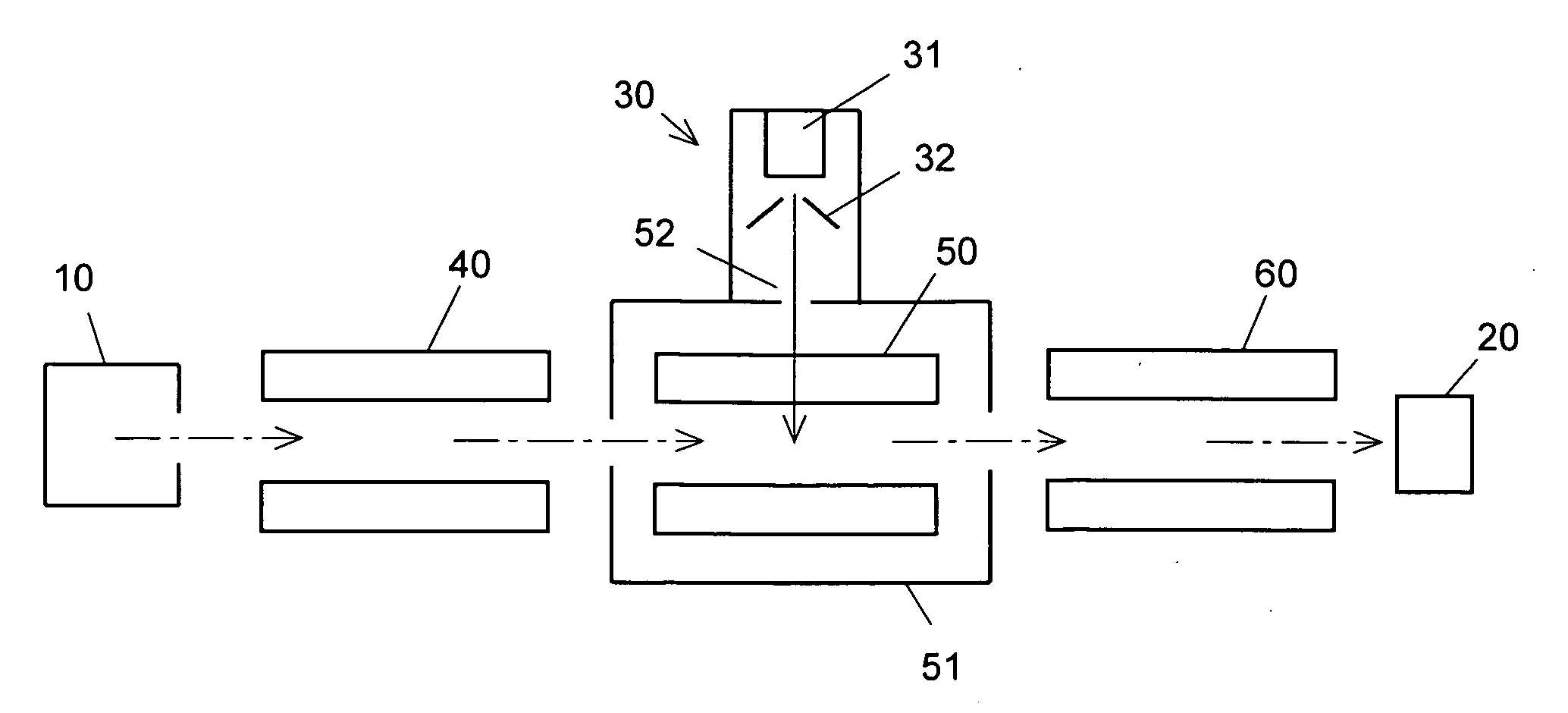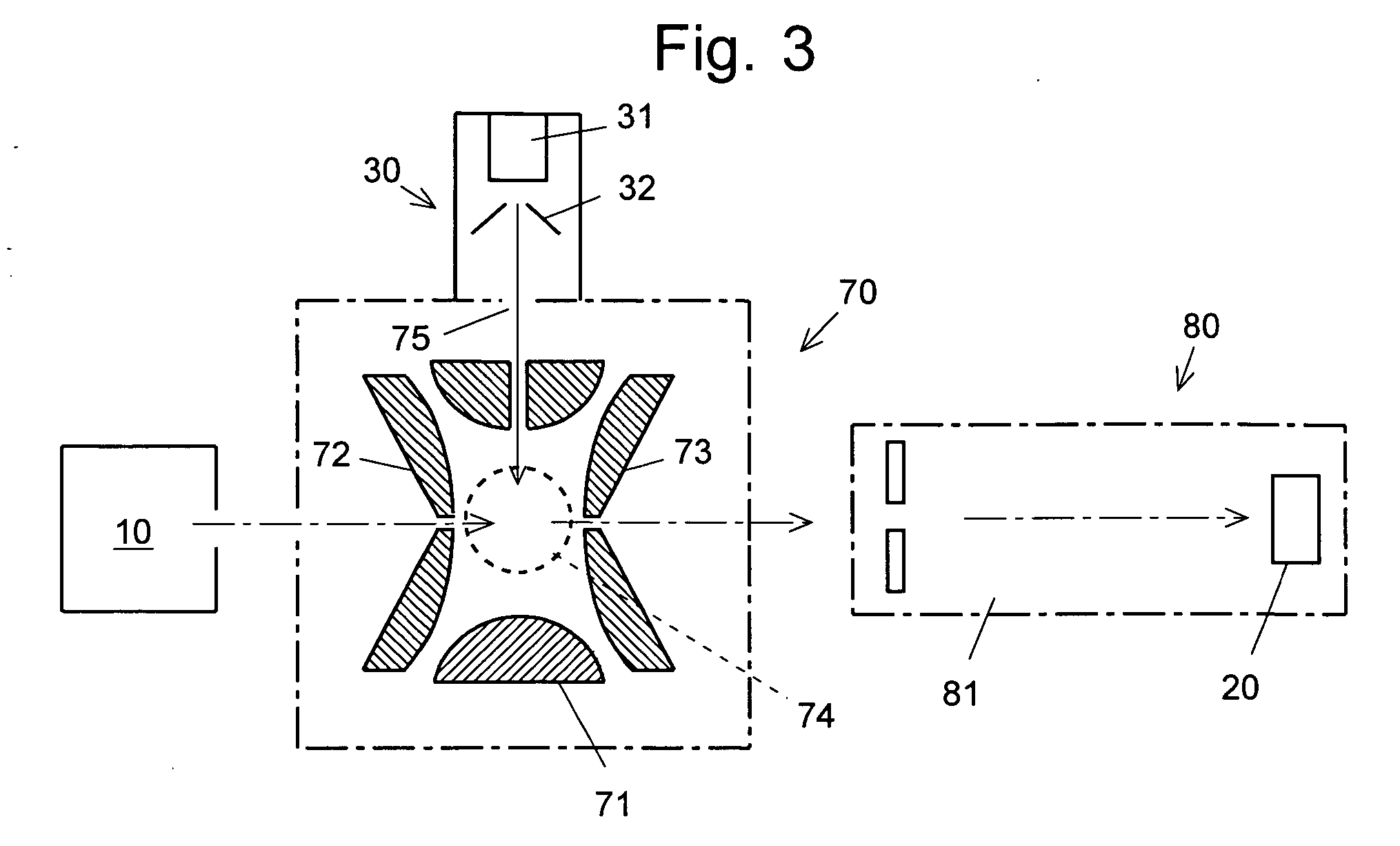Mass spectrometer
a mass spectrometer and mass spectrometer technology, applied in the field of mass spectrometers, can solve the problem that the method cannot provide information about the structure of such a large molecule, and achieve the effect of increasing the target mass
- Summary
- Abstract
- Description
- Claims
- Application Information
AI Technical Summary
Benefits of technology
Problems solved by technology
Method used
Image
Examples
first embodiment
[0043] [First Embodiment]
[0044]FIG. 1 schematically shows an example of the construction of the present invention applied to a tandem-in-space mass spectrometer having multiple mass separators connected in series. The mass spectrometer of the present embodiment is an MS / MS mass spectrometer using quadrupole mass filters as the mass separators. It includes an ion source 10, three sets of quadrupole mass filters (the first quadrupole mass filter 40, the second quadrupole mass filter 50, and the third quadrupole mass filter 60) and a detector 20, all of which are located within a vacuum chamber (not shown). The mass spectrometer also has a collision cell 51 enclosing the second quadrupole mass filter 50. The operation of each element is controlled by a controller (not shown) consisting of a central processing unit (CPU) and other devices.
[0045] The collision cell 51 is equipped with a cluster generator 30, which produces a strong cluster beam by performing an adiabatic expansion proce...
second embodiment
[0047] [Second Embodiment]
[0048]FIG. 2 schematically shows an example of the construction of the present invention applied to a tandem-in-time mass spectrometer for capturing, breaking and mass-analyzing the ion with a single mass spectrometer. The tandem-in-time mass spectrometer according to the present invention uses an ion trap as the aforementioned mass separator, including the ion source 10, an ion trap 70, the detector 20 and the cluster generator 30, all of which are located within a vacuum chamber (not shown). The ion trap 70 consists of a ring electrode 71 and a pair of end cap electrodes 72 and 73 facing each other across the ring electrode 71. A radio-frequency high voltage is applied to the ring electrode 71 to create a quadrupole electric field within the space surrounded by the ring electrode 71 and the two end cap electrodes 72 and 73. This space, in which ions are to be captured, is called the ion-capturing space 74 hereinafter. Meanwhile, an auxiliary alternating v...
third embodiment
[0050] [Third Embodiment]
[0051]FIG. 3 schematically shows another example of the construction of the present invention applied to a tandem-in-space mass spectrometer. In the present embodiment, the tandem-in-space mass spectrometer includes the ion trap 70 as the first mass separator and a time-of-flight mass spectrometer (TOFMS) 80 as the second mass separator. The ion source 10, the ion trap 70 and the TOFMS 80 are located within a vacuum chamber (not shown). The ion trap 70 is equipped with the cluster generator 30. These elements are operated by a controller (not shown).
[0052] A sample ion released from the ion source 10 is initially introduced into the ion trap 70, which performs the precursor selection process to trap a desired ion. Meanwhile, the cluster generator 30 supplies clusters into the ion-capturing space 74, where the CID process is performed to break the sample ion into fragment ions, as explained thus far. After an adequately long period of time for the dissociati...
PUM
 Login to View More
Login to View More Abstract
Description
Claims
Application Information
 Login to View More
Login to View More - R&D
- Intellectual Property
- Life Sciences
- Materials
- Tech Scout
- Unparalleled Data Quality
- Higher Quality Content
- 60% Fewer Hallucinations
Browse by: Latest US Patents, China's latest patents, Technical Efficacy Thesaurus, Application Domain, Technology Topic, Popular Technical Reports.
© 2025 PatSnap. All rights reserved.Legal|Privacy policy|Modern Slavery Act Transparency Statement|Sitemap|About US| Contact US: help@patsnap.com



